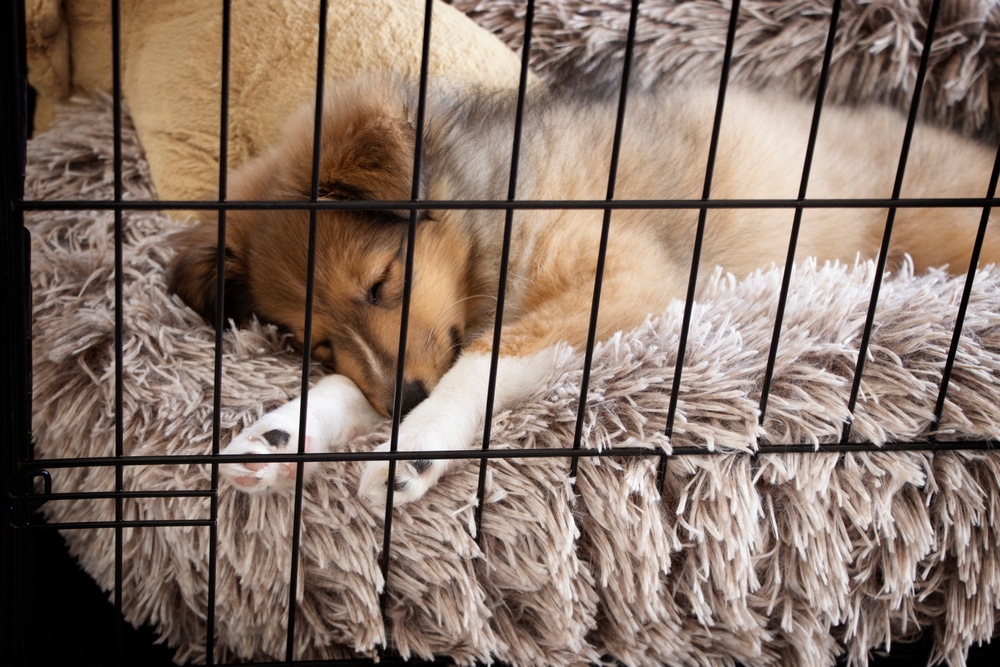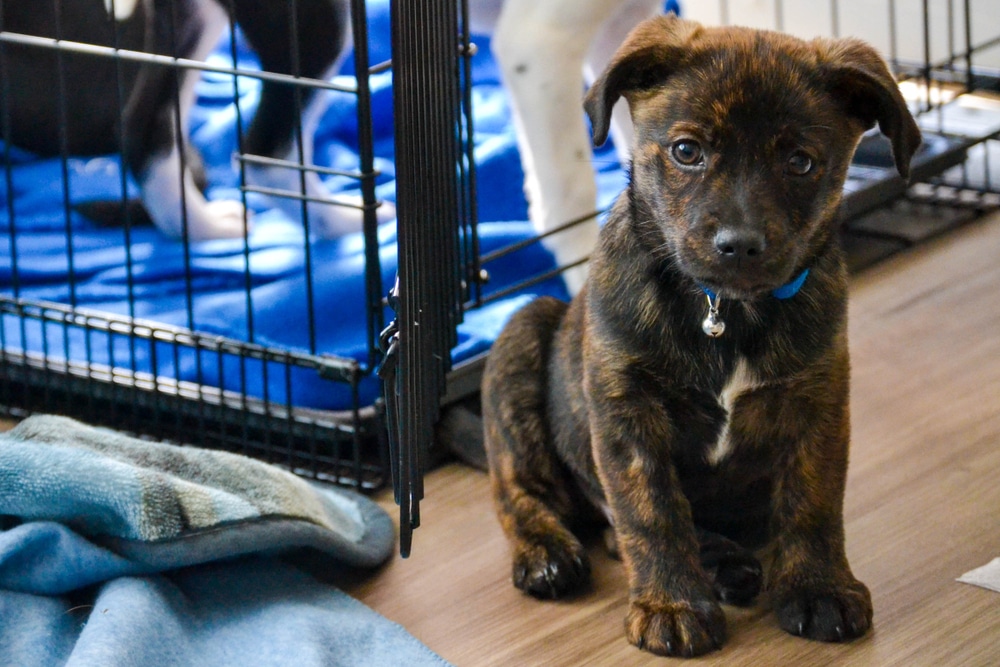Dogs are the true ambassadors of freedom and fun, as they love jumping, running, and playing all the time. But sometimes, this freedom can create inconvenience for their owners or even put them under threat. Is crate training a great solution to avoid such inconveniences? In short, as many ask, “Should I crate train my dog?”
You should crate train your dog as it offers many benefits. It helps in potty training, traveling, vet visits, and provides a safe space for your dog. It reduces the reach of indigestible and dangerous foods, provides a sense of serenity when away from home, and acts as a barrier to restrict unwanted meetups. Additionally, it can protect your household items from damage.
Table of Contents
- Why Crate Training Is Good For Your Dog
- It Helps With Potty Training
- It Also Helps With Travelling
- Your Dog Will Have Its Own Private Space
- It Makes Your Dog Calm And Comfortable
- Valuable Help In Vet Visits
- It Reduces The Reach Of Indigestible And Dangerous Foods
- Sense Of Serenity When Away From Home
- A Barrier To Restricting Unwanted Meetups
- Prevention Of Household Items From Damage
- Some Possible Cons of Crate Training
- Is Crate Training Cruel?
- How To Crate Train Your Samoyed
- In Conclusion: Should I Crate Train My Dog?
Why Crate Training Is Good For Your Dog

Crate training your furry friend has many positives and some of them are as follows.
It Helps With Potty Training
Crate training can help in potty training your dog. When your dog is in its crate, it will try to hold the poop or pee until you take it out. This helps it to understand that it should not pee or poop anywhere inside the house and that there are specific places for it.
It Also Helps With Travelling
Whether you need to travel frequently or occasionally, crate training is a must. Taking your dog on long trips can be challenging. But with the help of a crate, it becomes easier as it simulates the home environment, making your dog feel safer and more comfortable.
Your Dog Will Have Its Own Private Space
Just like humans, dogs also need their own private space. A crate provides a sense of security to your dog as it becomes its own private space where it can rest without any disturbance or distraction.
This helps in providing it with a secure environment to relax and stay calm when you are away.
It Makes Your Dog Calm And Comfortable
Crate training helps in creating a safe and comfortable environment for your dog. This can help in calming down an excited or agitated dog, as it feels secure and comfortable in its own den. This is especially beneficial if other dogs, noise, or people easily distract your dog.
Valuable Help In Vet Visits
Vet visits can be a stressful experience for your dog, as it may get overwhelmed by the new environment and other animals. It is important to have it get used to this kind of environment, and crate training helps in doing that.
By providing your dog with its own space, it will feel comfortable when taken for a vet checkup or any other visit too.
It Reduces The Reach Of Indigestible And Dangerous Foods
Dogs are naturally curious and love to explore their environment. But this curiosity can be dangerous, especially when it comes to food. By crate training your dog, you can ensure it will not get access to indigestible or dangerous foods that may be lying around the house and cause health issues.
Sense Of Serenity When Away From Home
Dogs have an attachment to their owners, and they constantly look for them when they are not at home. Dogs also find it difficult to stay alone. The crate helps in providing peace of mind to a dog.
A Barrier To Restricting Unwanted Meetups
If you have an excitable or curious dog, then crate training is important to ensure its safety. This will prevent it from running into potentially dangerous situations.
Crate training also helps in restricting meetups that can potentially be dangerous for your dog, as it will stay put in its own den and restrict any kind of access to potential hazards.
Prevention Of Household Items From Damage
Dogs can get excited and mischievous when left unsupervised, so confining them to their crate will help in making sure they don’t cause any damage. This way, you won’t have to worry as much about what they might get up to when you’re away.
Some Possible Cons of Crate Training
Crate training is not for everyone, and there are some possible cons that should be considered before you decide to go ahead with it. Some of them are the following.
The Wrong Size Can Put Your Dog Under Stress
It is important to use the right size crate. If the space is too small, then it will make your dog feel anxious and stressed. On the other hand, the dog won’t feel comfortable and secure in a larger crate.
A Poorly Ventilated Crate Can Become Lethal
The crates should be well-ventilated to ensure proper air circulation and prevention of poisonous gasses. It is important to check the crate regularly for any signs of suffocation or illness due to poor ventilation. Heat and humidity can build up in poorly ventilated crates and can become lethal for your pet.
Incorrect Crate Assembly Can Lead To An Injury
If you don’t put the crate together properly, then it can lead to an injury. Additionally, if the bolts and screws are not tight enough or missing altogether, then it may lead to an escape from the crate. It is important to make sure all parts are secure before using the crate.
Creates Anxiety Issues If Used For A Long Time Interval
Don’t use a crate for long periods of time as it can lead to anxiety issues. This is especially true if the dog spends several hours in a crate every day or all night. It is important to provide appropriate breaks and allow your dog some playtime with you in between crating.
Is Crate Training Cruel?
Crate training is often seen as an important part of puppyhood. But it’s a controversial issue—critics say that confining dogs to cages can be cruel and even cause behavior problems, while proponents emphasize its benefits.
The truth is that crate training isn’t necessarily always cruel, and it depends on how it is done. If a crate is used for too long periods of time and without proper management, then yes, it can be cruel and create behavioral issues. But when done properly, crate training can provide dogs with a safe space in which to stay while owners are away or unavailable.
Before you decide if crate training is right for your dog, consider its individual needs and personality. Dogs that experience anxiety or destructive behavior may find crates comforting. However, dogs with conditions such as arthritis and hip dysplasia should only be crated for short periods of time and monitored.
How To Crate Train Your Samoyed
Got a Samoyed? Then here are the steps to crate train one.
1. Select The Right Crate For Your Samoyed
When selecting the right crate, it’s important to consider your Samoyed’s size and age. You want a large enough crate so your dog can stand up, turn around, and stretch out comfortably. If you have a puppy, you may need to buy several crates as they grow.
2. Determine How Your Dog Feels More Comfortable
Some dogs prefer open crates, while others like the feeling of being enclosed. Or they may feel more at ease in a dark, enclosed space. If this is the case for your Samoyed, you can use a blanket or towel to cover their crate while they get comfortable.
Other Samoyeds may be more relaxed in an open space and may require less coverage.
3. Feed Your Dog Meals In the Crate
You can make your Samoyed comfortable in the crate by feeding it meals inside. A few times a week, feed your dog its meal in the crate with the door closed. Start off by leaving the door open and then gradually closing it for longer periods of time until your dog is comfortable eating its meals in the crate with the door shut.
4. Keep Your Dog In The Crate Without Any Leash Or Harness On
You shouldn’t use any leashes or harnesses during crate training. This way, your dog won’t feel restricted and will be more likely to go in and out of the crate without fear
5. Play Crate Games
Playing games that involve the crate can be a great way to help your Samoyed get more comfortable with it. You can start off by throwing treats inside and having your dog chase them. You can also hide toys inside and have your dog search for them. Over time, your Samoyed will begin to view its crate as an exciting place to explore.
6. Show Some Patience
The goal of crate training is to make your Samoyed feel comfortable and safe in their environment. This process may take some time, so it’s important you be patient with your dog. With the right steps and patience, you can crate train your Samoyed in no time!
In Conclusion: Should I Crate Train My Dog?
So, when it comes to, “Should I crate train my dog?” rate training can be an effective way to help your dog feel comfortable and secure. But it’s important to note it should only be done in the right environment and with the right steps. If done incorrectly or in an abusive manner, it can create serious behavioral issues. Consider your individual dog’s needs and personality before deciding if crate training is right for you.
So, what do you think about whether or not you should crate train your dog? Are you ready to get started or going to stay away? Let us know your thoughts and why in the comments below!
